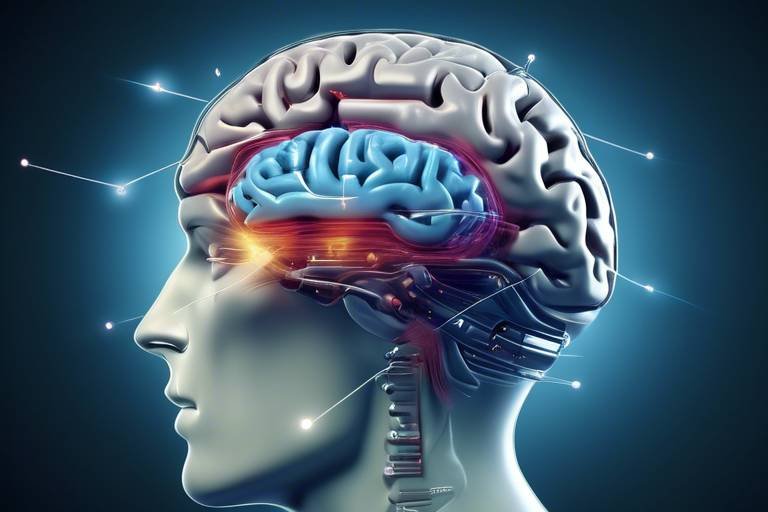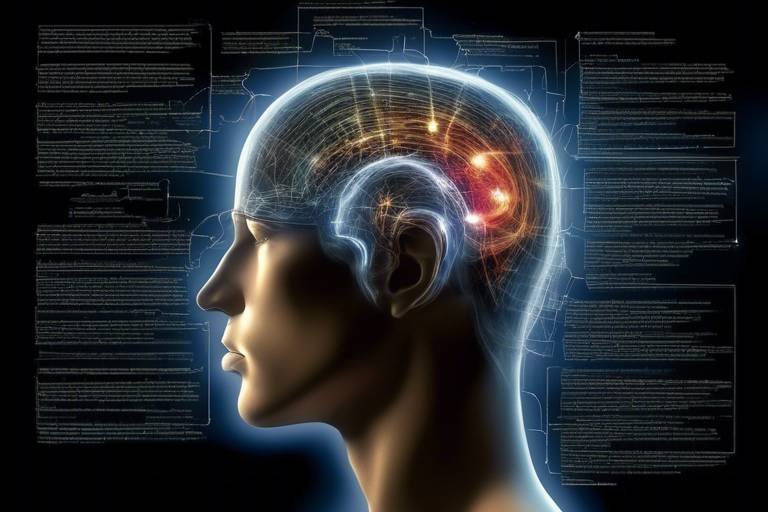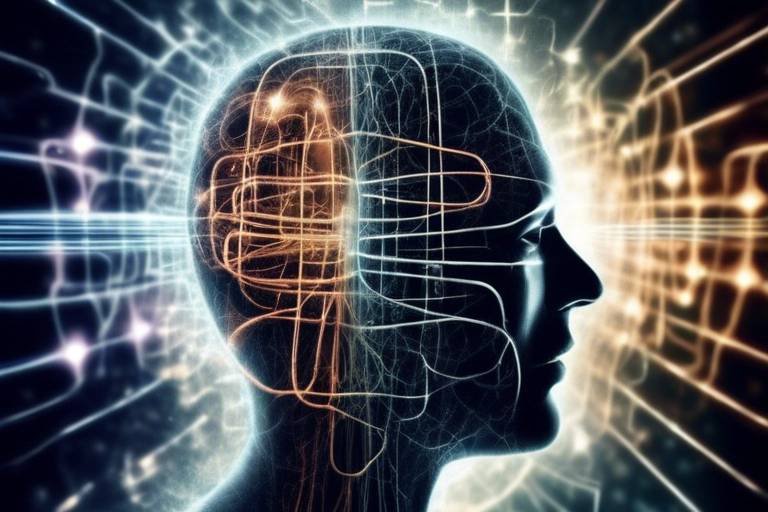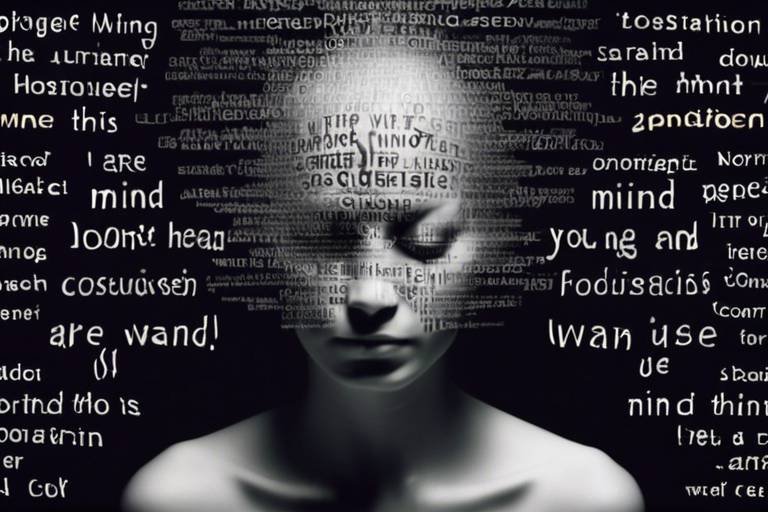The Basic Mechanisms of Consciousness in the Brain
Have you ever paused to wonder what truly makes you, *you*? The essence of our thoughts, feelings, and experiences boils down to one fascinating concept: consciousness. This article dives deep into the intricate web of processes that contribute to consciousness, exploring how the brain’s structures and functions intertwine to create our awareness and subjective experiences. Understanding consciousness is not just a scientific endeavor; it’s a journey into the very core of human existence.
To start, let’s unravel the mystery that is consciousness. Imagine your brain as a bustling city, where various structures serve as different districts, each playing a unique role in the grand scheme of things. Just like a city needs roads to connect its districts, our brain relies on neural pathways to communicate and coordinate activities across its various regions. This connectivity is what allows us to experience the world around us, respond to stimuli, and reflect on our thoughts. It’s a complex dance of neurons firing and synapses connecting, all contributing to the rich tapestry of our conscious experience.
But what exactly is consciousness? At its core, it’s the state of being aware of and able to think about one’s own existence, sensations, thoughts, and surroundings. It encompasses everything from the mundane—like feeling the warmth of the sun on your skin—to the profound, such as contemplating life’s biggest questions. Researchers have long been fascinated by consciousness, leading to a plethora of theories and hypotheses aimed at deciphering its mechanisms. From the philosophical musings of Descartes to modern neuroscientific approaches, the quest to understand consciousness is as old as humanity itself.
As we delve deeper into the brain’s architecture, we’ll encounter key players in the realm of consciousness. The thalamus, cortex, and brainstem are like the stars of our show, each contributing to the formation of conscious awareness in their own unique way. For instance, the thalamus acts as a relay station for sensory information, ensuring that the signals from our environment are integrated and processed effectively. It’s as if the thalamus is the conductor of an orchestra, coordinating the various instruments (or sensory inputs) to create a harmonious symphony of experience.
In this exploration, we’ll also touch on the different states of consciousness we experience daily, from the clarity of wakefulness to the mysteries of sleep and altered states. Each state is characterized by distinct patterns of brain activity, revealing just how dynamic and multifaceted consciousness truly is. So, buckle up as we embark on this fascinating journey through the mechanisms of consciousness in the brain, shedding light on the processes that make us who we are.
- What is consciousness? Consciousness is the state of being aware of and able to think about one’s own existence, sensations, thoughts, and surroundings.
- Which brain structures are involved in consciousness? Key structures include the thalamus, cortex, and brainstem, each playing a vital role in generating awareness.
- How does sleep affect consciousness? Sleep stages significantly influence our awareness and cognitive functioning, with different cycles leading to varied experiences of consciousness.
- Can altered states of consciousness be induced? Yes, altered states can be induced through various means, including substances and meditation, challenging traditional views of consciousness.

Neuroscience of Consciousness
The is a fascinating field that seeks to unravel the mysteries of how our brains create the rich tapestry of awareness we experience daily. Imagine your brain as a complex orchestra, where different instruments (or brain regions) play in harmony to produce the symphony of consciousness. This intricate interplay of neuronal activity is what allows us to perceive the world, think critically, and feel emotions. But how exactly does this work? Scientists have made significant strides in understanding the relationship between neural activity and conscious experience, revealing that consciousness is not merely a byproduct of brain function but a dynamic and evolving process.
One of the most compelling theories in this area is the Global Workspace Theory, which posits that consciousness arises from the integration of information across various brain regions. Think of it like a spotlight shining on certain thoughts or perceptions while leaving others in the shadows. This theory suggests that when information becomes globally accessible in the brain, it enters our conscious awareness. But what does this mean in practical terms? It implies that our conscious experience is a selective process, constantly filtering and prioritizing sensory input based on relevance and context.
Research has shown that specific brain regions are crucial for this integrative process. For instance, studies using functional MRI (fMRI) and electroencephalography (EEG) have indicated that the prefrontal cortex plays a significant role in decision-making and self-awareness, while the parietal cortex is essential for integrating sensory information. Together, these areas contribute to our ability to reflect on our thoughts and experiences, making us aware of our own consciousness.
Moreover, the concept of neural correlates of consciousness (NCC) has gained traction in recent years. NCC refers to the minimal set of neuronal events and mechanisms required for a specific conscious percept. By identifying these correlates, researchers aim to pinpoint the exact neural dynamics that give rise to various conscious experiences. This is akin to finding the right combination of ingredients that create a perfect dish; understanding NCC helps us grasp how different brain functions contribute to our awareness.
As we delve deeper into the neuroscience of consciousness, it's crucial to recognize that this field is still evolving. New technologies and methodologies are constantly emerging, allowing scientists to explore previously uncharted territories of the brain. For example, advancements in optogenetics enable researchers to manipulate specific neurons with light, providing unprecedented insights into how these neurons contribute to conscious experience. With each new discovery, we inch closer to understanding the profound question: what does it mean to be conscious?
In summary, the neuroscience of consciousness is a vibrant and rapidly advancing field that combines various disciplines, including psychology, neurobiology, and cognitive science. By studying the brain's structures and functions, scientists are beginning to piece together the puzzle of how consciousness arises. As we continue to explore this complex interplay of neural activity, we may unlock new insights into the very essence of human experience.

Brain Structures Involved
The human brain is a marvel of biological engineering, and at the heart of consciousness lie several key structures that work in concert to create our awareness and subjective experiences. Understanding these structures is like piecing together a complex puzzle; each piece plays a unique role in the grand picture of consciousness. The primary players in this intricate dance include the thalamus, cerebral cortex, and the brainstem. Each of these regions not only contributes to our conscious experience but also interacts with one another in ways that are still being unraveled by scientists today.
The thalamus, often referred to as the brain's relay station, is crucial for processing sensory information. Imagine it as a busy airport terminal, where incoming flights (sensory signals) are sorted and directed to their respective gates (cortical areas) for further processing. This sorting is essential; without it, our sensory experiences would be chaotic and disorganized. The thalamus filters and prioritizes sensory inputs, allowing only the most relevant information to reach the cortex, where higher-order processing occurs.
As we dive deeper into the thalamus's role, it becomes clear that its function extends beyond mere relay. It actively integrates sensory information, playing a pivotal role in our conscious awareness. For instance, when you touch a hot surface, the sensory information travels from your skin to the thalamus, which then sends it to the appropriate areas of the cortex. This process not only allows you to feel pain but also to react to it swiftly, highlighting the thalamus's role in our survival.
However, the thalamus is not infallible. Disruptions in its function can lead to profound alterations in consciousness. Conditions such as comas or vegetative states often involve thalamic dysfunction, emphasizing its importance in maintaining awareness. When the thalamus fails to relay sensory information properly, individuals may find themselves in a state where they are unable to interact with the world around them, raising critical questions about the nature of consciousness itself. Are they aware of their surroundings? What does it mean to be conscious if one cannot respond?
Another fascinating aspect of the thalamus is its connection to the cerebral cortex through what are known as thalamocortical loops. These loops are essential for maintaining consciousness and facilitating cognitive processes. Picture these loops as a feedback system, where the thalamus and cortex continuously communicate, ensuring that our conscious experience is coherent and integrated. This dynamic interaction is vital for everything from simple reflexes to complex decision-making processes.
The cerebral cortex, the outer layer of the brain, is where the magic happens when it comes to higher-order cognitive functions. It is responsible for our thoughts, perceptions, and decisions. The activity patterns within the cortex are closely linked to conscious thought; for example, when you make a decision, it is your cortex that processes the information and weighs the options. The complexity of these cortical functions can be likened to a grand orchestra, where each section plays its part to produce a harmonious symphony of conscious experience.
In summary, the thalamus, cortex, and brainstem work together in a sophisticated network that underpins our conscious awareness. Each structure contributes uniquely, and their interactions form the foundation of our subjective experiences. As we continue to explore these brain structures, we gain deeper insights into how consciousness arises and what it truly means to be aware.
- What is the primary function of the thalamus? The thalamus serves as a relay station for sensory information, integrating and processing inputs necessary for conscious awareness.
- How does the cerebral cortex contribute to consciousness? The cerebral cortex is vital for higher-order cognitive functions, including thought, perception, and decision-making, all of which are closely linked to conscious experience.
- What happens when the thalamus is damaged? Damage to the thalamus can lead to altered states of consciousness, such as comas or vegetative states, highlighting its crucial role in awareness.
- What are thalamocortical loops? Thalamocortical loops are feedback systems between the thalamus and cortex that help maintain consciousness and facilitate cognitive processes.

The Role of the Thalamus
The thalamus is often described as the brain's central hub, a critical relay station that processes and transmits sensory information to the appropriate areas of the cerebral cortex. Imagine it as a bustling train station, where various sensory inputs—like sights, sounds, and touch—arrive and are directed to their respective destinations. This structure not only plays a pivotal role in sensory perception but is also integral to our conscious experience. Without the thalamus, our ability to perceive the world around us would be severely impaired.
One of the most fascinating aspects of the thalamus is its involvement in the integration of sensory data. It doesn't just passively relay information; instead, it actively processes and filters inputs, ensuring that we are aware of the most relevant stimuli. For instance, when you hear a loud noise, the thalamus helps to prioritize that sound over background chatter, allowing you to focus on what’s important. This selective attention is crucial for navigating our complex environments and making quick decisions.
Moreover, the thalamus is not a standalone player in the game of consciousness. It works in tandem with the cortex through what are known as thalamocortical loops. These loops are essential for maintaining consciousness and facilitating higher cognitive functions. They allow for continuous communication between the thalamus and cortical regions, creating a dynamic feedback system that enhances our ability to process information and respond to our surroundings.
To illustrate the significance of the thalamus, consider the following table that summarizes its main functions:
| Function | Description |
|---|---|
| Relay Station | Processes and transmits sensory information to the cortex. |
| Integration of Sensory Data | Filters and prioritizes sensory inputs for conscious awareness. |
| Thalamocortical Loops | Facilitates communication between the thalamus and cortex. |
| Role in Attention | Helps focus on relevant stimuli while ignoring distractions. |
Understanding the thalamus's role in consciousness also sheds light on various neurological conditions. For example, disruptions in thalamic function can lead to altered states of consciousness, such as those observed in comas or vegetative states. These conditions highlight the thalamus's importance in maintaining awareness and responsiveness to the environment. When the thalamus is compromised, the brain's ability to process sensory information and generate conscious experience is severely impacted, illustrating just how vital this structure is for our everyday lives.
In conclusion, the thalamus is much more than just a relay station; it is a critical player in the orchestra of consciousness. Its ability to integrate sensory information, maintain communication with the cortex, and filter stimuli makes it an indispensable component of our conscious experience. Without it, our perception of the world would be fragmented and chaotic, underscoring the thalamus's essential role in shaping our awareness.
- What is the primary function of the thalamus?
The primary function of the thalamus is to act as a relay station for sensory information, processing and transmitting it to the appropriate areas of the cerebral cortex. - How does the thalamus affect consciousness?
The thalamus is crucial for maintaining consciousness as it integrates sensory data and facilitates communication between different brain regions. - What happens if the thalamus is damaged?
Damage to the thalamus can lead to altered states of consciousness, such as comas or vegetative states, affecting the brain's ability to process sensory information.

Thalamic Disorders and Consciousness
The thalamus, often dubbed the brain's "gateway to consciousness," plays a pivotal role in our awareness and sensory experiences. When this small yet mighty structure encounters disorders, the ramifications can be profound, leading to altered states of consciousness that challenge our understanding of awareness. Imagine trying to watch your favorite movie but having the screen flicker and fade intermittently; that’s akin to what happens when the thalamus fails to function properly.
Thalamic disorders can manifest in various ways, affecting everything from sensory perception to cognitive function. Conditions like thalamic stroke, traumatic brain injury, and certain neurodegenerative diseases can disrupt the thalamus's ability to relay information between different brain regions. This disruption can lead to states of consciousness that range from minimally conscious to completely unresponsive.
One of the most significant impacts of thalamic disorders is seen in patients who enter a vegetative state or a coma. In these conditions, individuals may appear awake, but they lack the awareness and responsiveness typically associated with consciousness. The thalamus's failure to communicate effectively with the cerebral cortex can result in a complete disconnection from the external world, leaving patients in a limbo of existence.
To better understand the effects of thalamic disorders, consider the following table that summarizes various conditions and their impact on consciousness:
| Condition | Description | Impact on Consciousness |
|---|---|---|
| Thalamic Stroke | Interruption of blood flow to the thalamus | Can lead to loss of awareness or altered sensory perception |
| Traumatic Brain Injury | Damage to the thalamus from an external force | May result in varying levels of consciousness, including coma |
| Neurodegenerative Diseases | Conditions like Alzheimer's that affect brain function | Progressive deterioration of awareness and cognitive abilities |
Moreover, understanding these disorders sheds light on the intricate relationship between the thalamus and consciousness. In patients recovering from thalamic injuries, researchers have noted that rehabilitation efforts focusing on sensory stimulation can sometimes help restore awareness. This observation highlights the thalamus's role not just as a relay station but as a critical hub for integrating sensory information that contributes to our conscious experience.
In conclusion, thalamic disorders serve as a reminder of the delicate balance required for consciousness. When the thalamus is compromised, it can lead to profound changes in how we experience the world around us. Understanding these conditions not only aids in better treatment options but also enhances our grasp of what it means to be conscious. It's a fascinating journey into the depths of our brain, revealing just how interconnected our neural pathways are with our very essence of being.
- What is the thalamus? The thalamus is a small structure located in the brain that acts as a relay station for sensory and motor signals to the cerebral cortex.
- How do thalamic disorders affect consciousness? Thalamic disorders can disrupt the communication between the thalamus and the cortex, leading to altered states of consciousness such as coma or vegetative states.
- Can thalamic function be restored? In some cases, rehabilitation and sensory stimulation can help restore thalamic function and improve awareness in patients recovering from thalamic injuries.
- What are some common thalamic disorders? Common disorders include thalamic strokes, traumatic brain injuries, and conditions associated with neurodegenerative diseases.

Thalamocortical Loops
The concept of is fundamental to understanding how our brain maintains consciousness and facilitates cognitive processes. These loops are intricate networks of communication between the thalamus and the cerebral cortex, acting like a finely tuned orchestra where each musician plays a vital role in producing a harmonious sound. Imagine the thalamus as the conductor, directing sensory information to various parts of the cortex, which in turn interprets and processes that information, creating our conscious experience.
At the heart of these loops lies the ability of the thalamus to relay sensory input to the cortex while also receiving feedback from the cortex itself. This bidirectional communication is crucial; it allows the brain to refine and modulate sensory information based on prior knowledge, expectations, and context. For instance, when you touch a hot surface, the thalamus quickly sends this sensory information to the cortex, which processes it and prompts an immediate reaction—pulling your hand away. This rapid exchange exemplifies how thalamocortical loops contribute to our awareness and decision-making processes.
Moreover, the dynamic nature of these loops is essential for maintaining conscious awareness. They are not static; instead, they adapt based on the demands of the environment and the internal state of the individual. For example, during focused attention, certain thalamocortical pathways may become more active, enhancing our ability to concentrate on a specific task while filtering out irrelevant stimuli. Conversely, when we are distracted or overwhelmed, these loops may struggle to prioritize information, leading to a fragmented conscious experience.
In addition to sensory processing, thalamocortical loops play a pivotal role in higher-order cognitive functions such as memory, learning, and emotional regulation. The feedback mechanisms within these loops allow the brain to integrate new information with existing knowledge, fostering learning and adaptation. This interplay is evident in various cognitive tasks, where the efficiency of these loops can significantly impact performance.
Understanding thalamocortical loops also sheds light on various neurological disorders. Disruptions in these loops can lead to altered states of consciousness, cognitive deficits, and sensory processing issues. For instance, conditions like schizophrenia and ADHD have been linked to abnormalities in thalamocortical connectivity, highlighting the importance of these loops in maintaining not just consciousness but also cognitive health.
In summary, thalamocortical loops are not merely pathways for sensory information; they are vital components of the brain's architecture that facilitate our conscious experience. By continuously adapting and responding to both internal and external stimuli, these loops help shape our awareness, influence our thoughts, and guide our actions in a constantly changing world.
- What are thalamocortical loops?
Thalamocortical loops are networks of communication between the thalamus and the cerebral cortex that play a crucial role in maintaining consciousness and cognitive functions. - How do thalamocortical loops affect consciousness?
These loops facilitate the integration of sensory information and feedback, allowing the brain to prioritize and modulate awareness based on context and experience. - What happens when thalamocortical loops are disrupted?
Disruptions can lead to altered states of consciousness and cognitive deficits, impacting conditions such as schizophrenia and ADHD. - Can thalamocortical loops influence learning?
Yes, they are essential for integrating new information with existing knowledge, which is crucial for effective learning and adaptation.

Cortical Contributions
The cerebral cortex is often referred to as the brain's "command center," and for good reason. This outer layer of the brain is responsible for a myriad of functions that are crucial to our conscious experience. Think of it as the stage where the drama of consciousness unfolds, with various actors (brain regions) playing their parts. The cortex is involved in everything from perception and thought to decision-making and emotional regulation. Its intricate network of neurons works tirelessly to weave together our sensory experiences into a coherent narrative that we recognize as our reality.
One of the most fascinating aspects of the cortex is its organization into different regions, each specializing in distinct functions. For instance, the visual cortex processes visual information, while the auditory cortex handles sounds. This specialization allows the brain to efficiently manage the vast amount of information it receives. However, it's not just about individual regions working in isolation; the true magic happens in the connections between these areas. The cortex communicates with itself and with other brain structures, forming a complex web of interactions that underlie conscious thought.
To illustrate the importance of these interactions, consider the concept of cognitive integration. This is where different types of information—like what we see, hear, and feel—come together to create a unified experience. For example, when you watch a movie, your visual cortex processes the images, while your auditory cortex interprets the sounds. Simultaneously, your emotional centers react to the story unfolding, which can make you feel joy, sadness, or suspense. This seamless integration is what allows us to fully engage with the world around us.
Moreover, the activity patterns within the cortex are closely linked to our conscious awareness. Researchers have discovered that specific patterns of brain activity correlate with different conscious states. When we are alert and focused, certain areas of the cortex show heightened activity, while during sleep or deep meditation, this activity diminishes. This relationship suggests that the cortex not only contributes to consciousness but also plays a role in modulating it. The more we understand these patterns, the better we can grasp how consciousness arises from the physical structure of the brain.
In summary, the contributions of the cortex to consciousness are both profound and intricate. Its specialized regions work in concert, integrating sensory information and shaping our conscious experiences. As science continues to explore these connections, we inch closer to unraveling the mysteries of how our brains create the rich tapestry of awareness we often take for granted.
- What is the primary function of the cerebral cortex?
The cerebral cortex is responsible for higher-order brain functions, including perception, thought, and decision-making. - How does the cortex contribute to consciousness?
The cortex integrates sensory information and communicates with other brain regions, creating a coherent experience of awareness. - What happens to cortical activity during sleep?
Cortical activity decreases during sleep, but certain stages, like REM sleep, show unique patterns associated with dreaming. - Can the cortex be affected by external substances?
Yes, substances like drugs and alcohol can alter cortical function, impacting perception and consciousness.

States of Consciousness
When we think about consciousness, it's like peering through a complex lens that reveals a spectrum of experiences. Our state of consciousness can shift dramatically, influenced by a myriad of factors, from our environment to our internal mental processes. Understanding these states is crucial, as it helps us grasp how our brain operates under different conditions. Essentially, consciousness can be categorized into several distinct states, including wakefulness, sleep, and various altered states that can arise from substances or practices like meditation.
During wakefulness, our brain is fully engaged with the world around us. This state is characterized by heightened awareness, where sensory inputs are processed, and cognitive functions are at their peak. In this state, the brain exhibits a specific pattern of neural activity that allows us to interact meaningfully with our surroundings. Think of it as a vibrant symphony where every instrument plays in harmony, creating a rich tapestry of experiences. However, as we transition into sleep, the dynamics of our consciousness change fundamentally.
Sleep is not merely a passive state; it is a complex process that involves several stages, each with unique characteristics. The brain cycles through different phases, including REM (Rapid Eye Movement) and NREM (Non-Rapid Eye Movement). During REM sleep, for instance, our brains are highly active, resembling wakefulness, yet our bodies are in a state of paralysis. This paradoxical state is where most dreaming occurs, allowing our minds to wander and explore the depths of our imagination. In contrast, NREM sleep is associated with restorative processes, where the brain consolidates memories and rejuvenates itself. The following table summarizes the key differences between these sleep stages:
| Stage | Characteristics | Brain Activity |
|---|---|---|
| Awake | Fully alert, engaged with surroundings | High frequency, low amplitude |
| NREM Sleep | Deep sleep, restorative processes | Low frequency, high amplitude |
| REM Sleep | Active dreaming, muscle paralysis | Similar to awake state |
Now, let’s not forget about altered states of consciousness. These states can be induced by various factors, such as drugs, meditation, or even extreme physical exertion. When we engage in meditation, for example, we might experience a profound sense of tranquility and heightened awareness. This state can feel like stepping into a serene oasis amidst the chaos of daily life. On the other hand, substances like alcohol or psychedelics can drastically alter our perception, leading to experiences that challenge our conventional understanding of reality. It’s as if our brain is playing with the dials of consciousness, tuning into frequencies we rarely access in our waking life.
In exploring these altered states, we often encounter a fascinating phenomenon: the subjective experience of reality can shift dramatically. People report feelings of euphoria, interconnectedness, or even profound insights about existence. These experiences can be enlightening, but they also raise questions about the nature of consciousness itself. Are these states genuine expansions of awareness, or are they merely illusions crafted by the brain's chemistry? The debate continues, but what remains clear is that our understanding of consciousness is an ever-evolving field, rich with mysteries waiting to be unraveled.
- What are the main states of consciousness? The main states include wakefulness, sleep (NREM and REM), and altered states induced by substances or practices.
- How does sleep affect consciousness? Sleep stages significantly influence awareness and cognitive functions, with REM sleep being crucial for dreaming and memory consolidation.
- Can altered states of consciousness be beneficial? Yes, many people find that altered states, especially those induced by meditation, can lead to personal insights and emotional healing.

Sleep and Consciousness
When we think about sleep, we often picture a peaceful escape from the chaos of daily life, but did you know that sleep is a complex state that significantly influences our consciousness? It's like a mysterious theater where our brain performs a series of intricate plays, each with its own unique script and cast of characters. During sleep, our awareness of the external world fades, yet our brain remains incredibly active, engaging in various processes that are vital for our overall well-being.
To understand how sleep affects consciousness, we must first explore the different stages of sleep. These stages can be broadly categorized into two types: REM (Rapid Eye Movement) and NREM (Non-Rapid Eye Movement) sleep. Each type plays a distinct role in our cognitive functioning. For instance, during REM sleep, the brain is highly active, and this is when most of our vivid dreams occur. It's almost as if our mind is in a creative frenzy, crafting stories and scenarios that can feel as real as life itself.
On the other hand, NREM sleep, which consists of three stages, is crucial for physical restoration and memory consolidation. The deeper we go into NREM sleep, the less responsive we become to external stimuli, indicating a shift in our level of consciousness. This is where our brain recharges and processes information from the day, ensuring that we wake up refreshed and ready to tackle new challenges.
| Stage of Sleep | Characteristics | Impact on Consciousness |
|---|---|---|
| NREM Stage 1 | Light sleep, transition between wakefulness and sleep | Awareness begins to diminish |
| NREM Stage 2 | Deeper sleep, body temperature drops, heart rate slows | Further reduction in awareness |
| NREM Stage 3 | Deep sleep, restorative processes occur | Minimal awareness, difficult to awaken |
| REM Sleep | Brain activity resembles wakefulness, dreaming occurs | Heightened awareness during dreams |
Interestingly, the interplay between these stages can lead to fascinating phenomena. Have you ever woken up from a dream and felt a lingering sense of confusion about what was real? That’s because during REM sleep, the brain is processing emotions and experiences, which can sometimes bleed into our waking consciousness. This blending of states can lead to profound insights or, at times, unsettling feelings. It's a reminder of how fluid our consciousness can be.
Moreover, the quality of our sleep directly influences our wakeful consciousness. Poor sleep can lead to a foggy mind, impaired judgment, and diminished emotional regulation. It’s like trying to drive a car with fogged-up windows; you can’t see clearly, and your reactions are delayed. On the flip side, quality sleep enhances our cognitive abilities, allowing us to think clearly, make better decisions, and maintain emotional balance. So, the next time you find yourself struggling to focus, consider whether you’ve been getting enough zzz’s!
In summary, the relationship between sleep and consciousness is a fascinating dance. Each stage of sleep contributes to our overall awareness and cognitive function, highlighting the importance of a good night’s sleep for maintaining a healthy mind. Understanding this connection can empower us to prioritize our sleep, ensuring that we wake up not just rested, but also with a sharper, more vibrant sense of consciousness.
- What is the difference between REM and NREM sleep?
REM sleep is characterized by rapid eye movement and dreaming, while NREM sleep includes lighter stages of sleep that are essential for physical restoration. - How does sleep affect memory?
Sleep, particularly NREM sleep, plays a crucial role in memory consolidation, helping to strengthen and store memories from the day. - Can lack of sleep affect my consciousness?
Yes, insufficient sleep can lead to impaired cognitive function, reduced awareness, and emotional instability.

Altered States
Altered states of consciousness are fascinating phenomena that challenge our understanding of the mind and brain. These states can be induced by a variety of factors, including substances, meditation, and even extreme sensory deprivation. Have you ever wondered how a simple cup of herbal tea can lead to a profound sense of relaxation, or how a powerful psychedelic experience can shift your perception of reality? The brain is a complex organ, and its ability to shift into different states of consciousness reveals much about its intricate workings.
When we think about altered states, we often picture the vivid experiences brought on by substances like LSD or psilocybin. These substances can lead to intense visual and auditory hallucinations, a feeling of unity with the universe, or a sense of timelessness. But what’s happening in the brain during these experiences? Research shows that these substances can significantly alter neural connectivity, especially in areas associated with self-awareness and perception.
For instance, studies have indicated that psychedelics may reduce activity in the default mode network (DMN), a network of brain regions that is highly active when we are at rest and not focused on the external environment. This reduction can lead to a dissolution of the ego, allowing individuals to experience a sense of interconnectedness with their surroundings. It’s almost like the brain is temporarily rewiring itself, creating a new framework for understanding consciousness.
On the other hand, practices like meditation can also induce altered states, but in a very different manner. Meditative states are often characterized by a profound sense of calm and clarity. During meditation, brain scans reveal increased activity in areas associated with attention and emotional regulation, while simultaneously reducing activity in regions linked to stress and anxiety. This shift can lead to a heightened sense of awareness and a deeper connection to one’s thoughts and feelings.
Interestingly, altered states can also occur in everyday situations. Think about those moments when you lose track of time while engrossed in a book or get swept away in music. These experiences, often referred to as "flow states," illustrate how consciousness can fluctuate based on our engagement with the world around us. In these moments, the brain is fully immersed in the present, enhancing our creativity and problem-solving abilities.
In summary, altered states of consciousness serve as a window into the complexities of the human mind. They remind us that our perception of reality is not fixed but rather a dynamic interplay of brain activity, sensory input, and cognitive processes. Whether through substances, meditation, or the simple act of losing ourselves in an activity, exploring these states can offer profound insights into the nature of consciousness itself.
- What are altered states of consciousness?
Altered states of consciousness refer to any mental state that differs from the normal waking state, including those induced by substances, meditation, or extreme sensory deprivation.
- How do psychedelics affect the brain?
Psychedelics can alter neural connectivity and reduce activity in the default mode network, leading to experiences of ego dissolution and heightened perception.
- Can meditation change consciousness?
Yes, meditation can induce altered states characterized by increased attention and emotional regulation, promoting a sense of calm and clarity.
- What is a flow state?
A flow state occurs when an individual is fully immersed in an activity, leading to a sense of timelessness and enhanced creativity.
Frequently Asked Questions
- What is consciousness?
Consciousness is the state of being aware of and able to think about one’s own existence, thoughts, and surroundings. It encompasses everything from our thoughts and feelings to our perceptions and experiences in the world around us.
- How does the brain contribute to consciousness?
The brain contributes to consciousness through complex interactions between various structures, primarily the thalamus and cerebral cortex. These areas work together to process sensory information and facilitate awareness, allowing us to experience thoughts and feelings.
- What role does the thalamus play in consciousness?
The thalamus acts as a relay station for sensory inputs, integrating and processing information that is crucial for conscious awareness. It helps filter and direct sensory data to the appropriate areas of the cortex, ensuring we can respond to our environment effectively.
- Can thalamic disorders affect consciousness?
Yes, disruptions in thalamic function can lead to altered states of consciousness, such as comas or vegetative states. Understanding these disorders helps researchers learn more about the thalamus's vital role in maintaining awareness and cognitive function.
- What are thalamocortical loops?
Thalamocortical loops are the interactions between the thalamus and the cortex that are essential for maintaining consciousness. These loops facilitate communication between the two regions, playing a critical role in cognitive processes and overall awareness.
- How does sleep affect consciousness?
Sleep stages significantly influence consciousness, with different cycles affecting our awareness and cognitive functioning. During certain sleep phases, our brain activity changes, impacting our ability to be aware of our surroundings and our mental processes.
- What are altered states of consciousness?
Altered states of consciousness refer to conditions that differ from normal waking awareness, often induced by substances, meditation, or other practices. These states can challenge traditional views of consciousness, revealing the brain's capacity for diverse experiences.
- How do researchers study consciousness?
Researchers study consciousness through various methods, including neuroimaging techniques like fMRI and EEG, which allow them to observe brain activity and identify the neural correlates of conscious experience. They also explore behavioral studies and philosophical inquiries to deepen their understanding.
- Is consciousness the same as awareness?
While closely related, consciousness and awareness are not exactly the same. Consciousness encompasses a broader range of experiences, including thoughts and feelings, while awareness specifically refers to the recognition of stimuli in the environment and one’s own internal states.



















